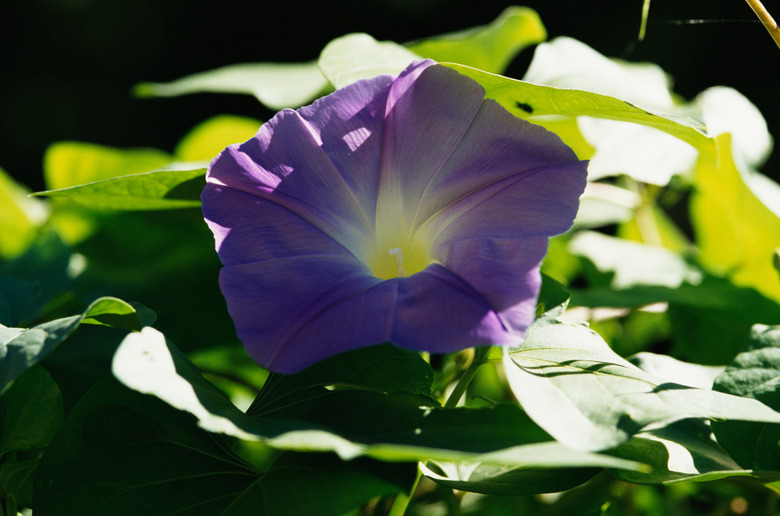Bugs That Like Morning Glory Flowers
Morning glory flowers thrive in flower beds in full sun and are often used as a ground cover. These flowers are generally healthy and mostly free from damaging insects. However, two common pests can infest morning glory and damage its health and appearance. Both aphids and spider mites are sucking pests that can damage morning glory by feeding on its leaves.
Step 1
Two bugs that favor morning glory flowers are sucking pests. Aphids are pear-shaped bugs that come in a variety of colors such as black, red, green, pink, yellow and brown. Some aphids have see-through wings and others are wingless. All aphids are small and difficult to see with the naked eye. Another common pest of morning glory flowers are spider mites. These eight-legged pests are often found feeding on a variety of ornamental plants, flowers and shrubs. Spider mites typically feed on the bottoms of plant leaves, sucking sap from the foliage with sharp mouth parts. Morning glory often sustain significant feeding damage before spider mite infestations are noticed. Spider mites may be detected by shaking flowers or leaves over a white sheet of paper. If spider mites are present on your plant, they will fall onto the paper.
Step 2
- Two bugs that favor morning glory flowers are sucking pests.
Effects
Step 1
Morning glory flowers that have aphid infestations may develop gray or yellow flecks in the leaves and leaves may become distorted. While removing plant sap from the leaves of morning glory, aphids excrete honeydew. This sticky substance adheres to the surface of morning glory flowers and causes mold fungi to stick there, as well. This condition is known as sooty mold, which received its name for its close resemblance to chimney soot. This condition is not harmful to morning glory health but does cause the plant to become an unsightly, sticky mess. Spider mites often place webs spun from silk onto morning glory flowers, stems and leaves. This web is a sign of heavy spider mite infestation. Other symptoms associated with spider mite infestations include yellowing of leaves, egg shells at the base of the plant and leaf bronzing. Heavy spider mite feeding causes leaves to become stippled or flecked and infested plants suffer from reduced vigor and poor health.
Step 2
- Morning glory flowers that have aphid infestations may develop gray or yellow flecks in the leaves and leaves may become distorted.
- Other symptoms associated with spider mite infestations include yellowing of leaves, egg shells at the base of the plant and leaf bronzing.
Cultural Control
Step 1
A variety of natural predators feed on aphids and spider mites in your garden. Lady beetles, parasitic wasps, assassin bugs and praying mantis are all natural predatory insects that feed on aphids and spider mites, keeping them under control. Avoid using insecticides on your morning glory if predatory insects are present, as these products typically kill predatory insects and can cause a spike in aphid or spider mite population. Another method that is often successful in keeping aphids and spider mites under control is syringing. Syringing is the process of washing your plants with a hard stream of water, which knocks the bugs from the plants. Repeat this process at least two times each week for optimal control.
Chemical Control
Step 1
Insecticidal soaps are often used to keep aphids and spider mites under control in outdoor plants. Apply insecticidal soap to the entire plant, concentrating on the underside of plant leaves where pests gather. Horticultural oils are also effective in reducing damaging pests. Oil-based products may also help loosen and remove sooty mold fungi, which is often present with sucking pests that excrete honeydew. Both insecticidal soaps and horticultural oils must make contact with bugs to work effectively. Miticides are also available for spider mite control; choose a pyrethroid product for best results.
Step 2
- A variety of natural predators feed on aphids and spider mites in your garden.
- Insecticidal soaps are often used to keep aphids and spider mites under control in outdoor plants.
